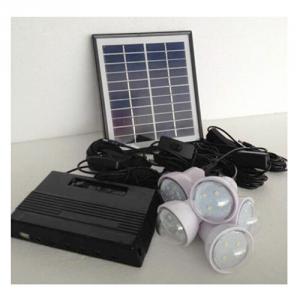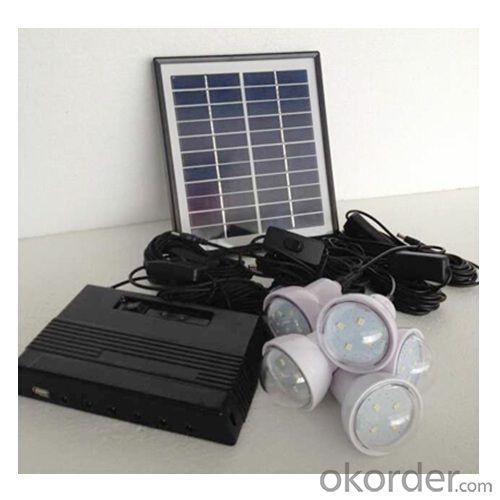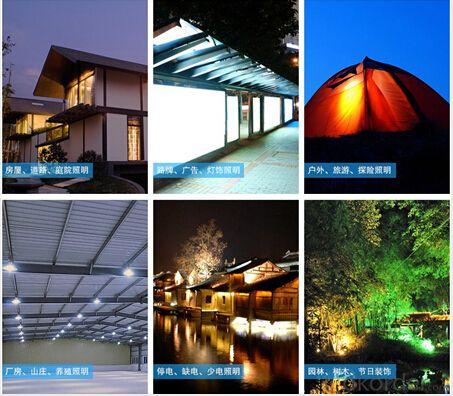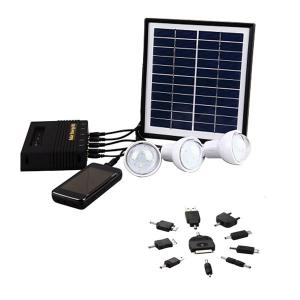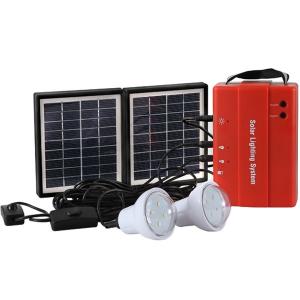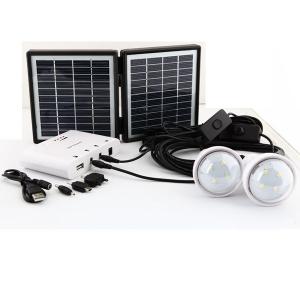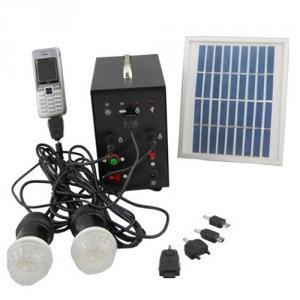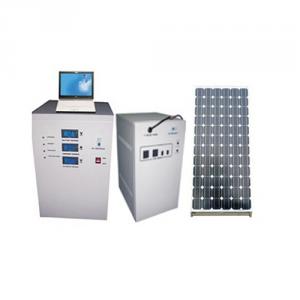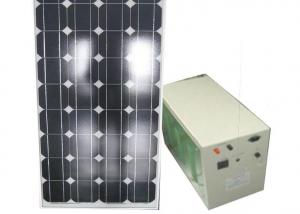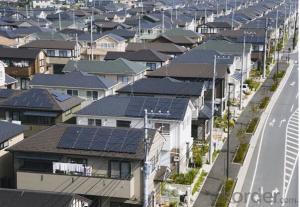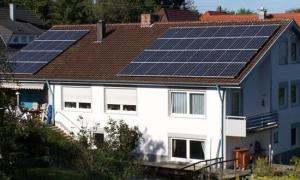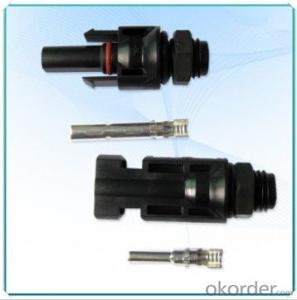Wind Solar Energy Systems - 4W Solar Lighting System with Mobile Charge, 4W Solar Panel, 5200mAh Lithium Battery, Black CE ROHS
- Loading Port:
- Shenzhen
- Payment Terms:
- TT/LC
- Min Order Qty:
- 100Sets set
- Supply Capability:
- 20000 SETS Per Month set/month
OKorder Service Pledge
OKorder Financial Service
You Might Also Like
This 4w solar lighting system with mobile charge 4w solar panel 5200mah lithium batetry black with CE ROHS is a portable solar energy system , with 5200mah li-ion battery . This solar energy generator can generate power for 5 LED bulbs, it can work 6 to 30 hours every day.
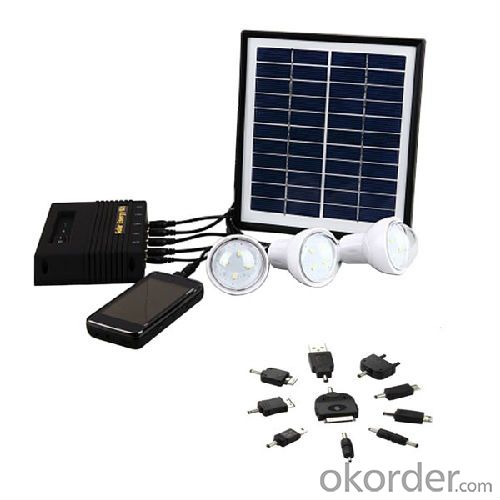
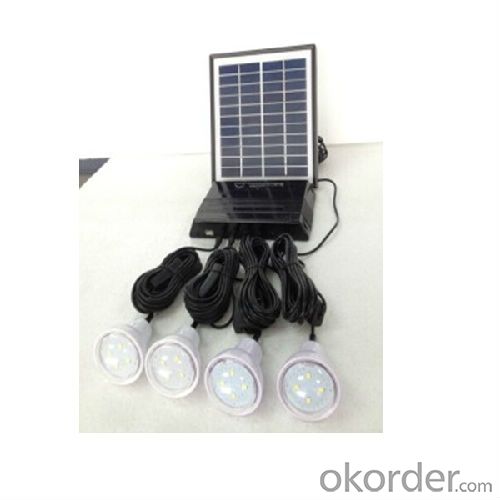
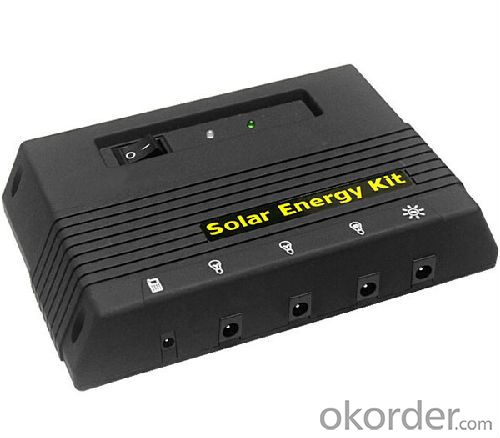
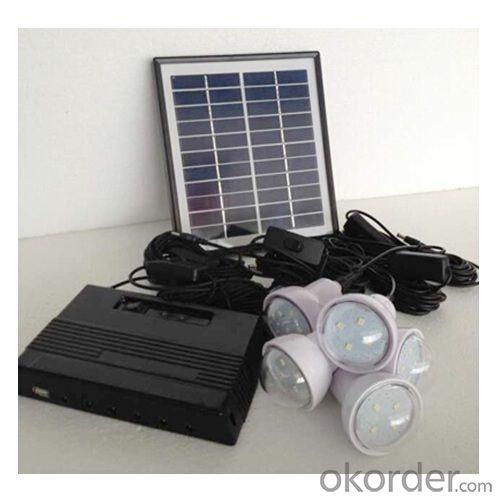
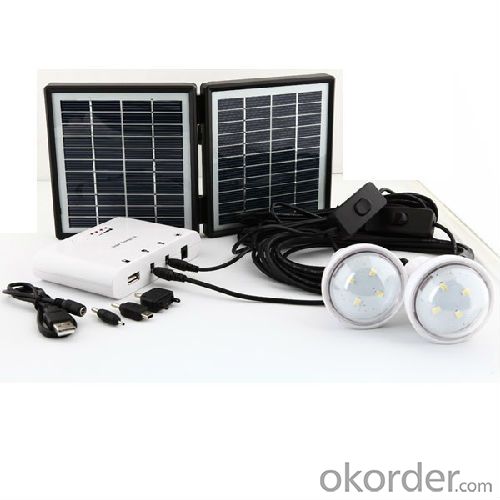
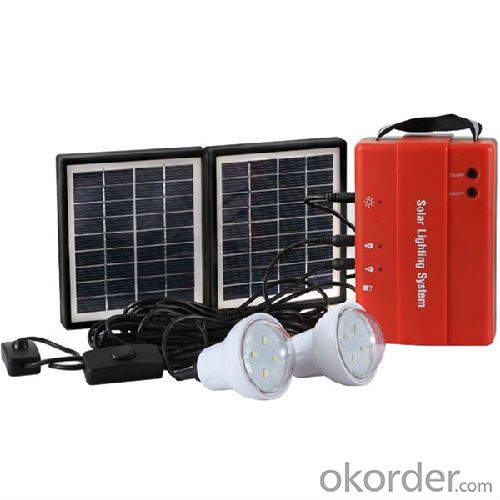

Feature
| Solar Panel: 4W 11V |
| Battery: 5200mAh 7.4V lithium |
| Light Source: 0.9W LED bulb*5 pcs |
| 7.4V 5200mAh Lithium battery |
| 4W 11V Solar Panel with 5M cable |
| 0.9W LED bulb with 5pcs |
| LED bulb: each with 5M cable and switch on cable, IP54. |
| LED charging indicator: yes |
| Mobile phone charging: USB port 5V 1000mA output, with 5-in-1 USB mobile charging cable (Nokia 6101,Sumsung G600, Micro USB, Mini USB,Iphone 4/4S) |
| Overcharge and overdischarge protection: yes |
| Rechargeable by AC charger: optional |
| Working hours on full battery |
| 5 bulbs-6 hours |
| 4 bulbs-7.5 hours |
| 3 bulbs-10 hours |
| 2 bulbs-15 hours |
| 1 bulb-30 hours |
| Full charging time |
| By solar-16 hours (under direct sunshine) |
| By AC charger-about 11 hours |
Usage/Applications
Rural homes, campers, fishermen, outdoor campaigns or activities, etc. Remote area, mountainous area, desert area, grassland area,
Village, country area, Camping, outdoor activities, travel, Lighting at night.
Customized options
1. OEM/ODM available;
2. It's also available to customize your own solar lighting systems, solar lanterns, or any solar lighitng products by giving us solar lights picture / 3D draft / technical datas.
Packing & Delivery
Package:
1* solar panel
1* portable system box
5* LED bulbs with on/off button on cable
inner box size: 335*255*84mm
10pcs/carton
carton size: 525*350*450mm
Delivery:
|
Shipping Service |
Estimated Delivery Time |
|
DHL |
2-8 business days |
|
FedEx |
3-8 business days |
|
TNT |
2-10 business days |
|
UPS |
1-7 business days |
|
EMS |
6-14 business days |
|
ePacket |
7-12 business days |
|
China Post Air Mail |
7-15 business days |
|
China Post SAL |
14-30 business days |
|
Air freight |
3-10 business days |
|
By Sea |
30-40 business days |
1. 3-5 business days for Sample Orders; 7-30 business days for Bulk Orders for Bulk Orders.
2. "Business days" means Monday-Friday, excluding holidays.
3. DHL and UPS cannot ship to military or P.O. boxes address
4. The Shipping Service above is for reference only, for any other questions, please feel free to contact us.
Factory

- Q: How does shading affect the performance of solar energy systems?
- Shading can significantly impact the performance of solar energy systems by reducing the amount of sunlight that reaches the solar panels. This decreases the overall energy production and efficiency of the system. Even partial shading on a small portion of the panels can lead to significant power losses, as solar panels are interconnected and work as a whole. Therefore, it is crucial to design solar installations in areas with minimal shading to maximize their performance and optimize energy generation.
- Q: How does the installation of solar panels affect the roof's warranty?
- The installation of solar panels typically does not void the roof's warranty. However, it is important to consult with the roofing manufacturer and installer to ensure that the installation process does not breach any warranty conditions.
- Q: How does solar energy impact job creation?
- Solar energy impacts job creation by creating a significant number of employment opportunities in various sectors such as manufacturing, installation, maintenance, and research and development. The growth of the solar energy industry has led to the creation of numerous jobs, both in the renewable energy sector and related industries. This includes positions for engineers, technicians, project managers, salespeople, and more. Additionally, as solar energy becomes more affordable and widely adopted, it stimulates economic growth and encourages investments, further boosting job creation in local communities.
- Q: Can a solar energy system be installed on a library or educational institution?
- Indeed, the installation of a solar energy system on libraries and educational institutions is possible. This approach has gained popularity among many of these establishments as an effective and eco-friendly solution to their energy requirements. By adopting solar energy, libraries and educational institutions not only cut down on electricity costs but also demonstrate their dedication to clean energy and environmental consciousness. Libraries and educational institutions often boast expansive rooftops or available open spaces that make them perfect candidates for solar panel installation. These panels can be affixed to the roof or positioned on the ground, depending on the space available and structural considerations. Moreover, solar panels can even be incorporated into building materials like windows or walls, offering aesthetically pleasing and innovative installations. By embracing solar energy, libraries and educational institutions can generate their own electricity and reduce their dependence on fossil fuels. This approach can lead to substantial long-term savings since solar energy is a renewable resource that does not require ongoing fuel expenses. Additionally, any excess electricity produced by the solar panels can be fed back into the grid, enabling libraries and educational institutions to contribute to the local energy supply and potentially receive incentives or credits from the government. Furthermore, the installation of solar panels on libraries and educational institutions can serve as a valuable educational tool. It creates an opportunity to educate students, staff, and the community about the advantages of renewable energy, energy preservation, and environmental stewardship. Schools and libraries can incorporate the solar energy system into their curriculum, offering a hands-on learning experience and engaging students in comprehending the scientific, technological, and environmental aspects of solar energy. In conclusion, libraries and educational institutions can benefit from the installation of a solar energy system, offering advantages such as cost savings, environmental sustainability, and educational opportunities. The decision to opt for solar energy aligns with the values held by these establishments and showcases their commitment to a cleaner, more sustainable future.
- Q: How do solar energy systems impact the reliability of the electrical grid?
- Solar energy systems can have both positive and negative impacts on the reliability of the electrical grid. On the positive side, solar energy systems can enhance the reliability of the grid by diversifying the sources of electricity generation. Traditional power plants heavily rely on fossil fuels, which are finite and prone to price volatility. By integrating solar energy systems into the grid, we can reduce the dependence on fossil fuels and increase the share of renewable energy sources, which are typically more stable and sustainable. Additionally, solar energy systems can improve grid reliability by decentralizing power generation. Traditional power plants are usually centralized, which means that a disruption at one facility can lead to widespread blackouts. In contrast, solar energy systems are typically distributed across various locations, which reduces the risk of a single point of failure and enhances the overall resilience of the grid. However, solar energy systems also pose certain challenges to grid reliability. One of the main concerns is the intermittent nature of solar power generation. Solar panels only produce electricity when exposed to sunlight, which means that their output can fluctuate throughout the day and is completely absent during nighttime. This intermittency can create challenges in matching the supply and demand of electricity in real-time, potentially destabilizing the grid. To address this issue, grid operators need to implement effective energy storage solutions, such as batteries, to store excess solar energy during peak production periods and release it during periods of low or no solar generation. Additionally, advanced forecasting and grid management technologies can help predict and balance the intermittent nature of solar energy, ensuring a reliable and stable electricity supply. In conclusion, while solar energy systems can enhance the reliability of the electrical grid by diversifying energy sources and decentralizing power generation, their intermittent nature poses challenges that need to be addressed through energy storage and efficient grid management techniques. Overall, with proper planning and integration, solar energy systems can contribute to a more reliable and sustainable electrical grid.
- Q: Are there any risks of electrical arcing with solar energy systems?
- Yes, there are risks of electrical arcing with solar energy systems. Electrical arcing can occur due to various factors such as faulty wiring, loose connections, or damaged components. This can lead to fires, damage to the system, and potential harm to individuals nearby. Therefore, proper installation, regular maintenance, and adherence to safety guidelines are crucial to minimize the risks of electrical arcing in solar energy systems.
- Q: Can solar energy systems be used in areas with high levels of dust or dirt?
- Yes, solar energy systems can be used in areas with high levels of dust or dirt. However, excessive accumulation of dust or dirt on solar panels can reduce their efficiency. Regular cleaning and maintenance of solar panels are essential to ensure optimal performance in such areas.
- Q: What is the efficiency of a solar energy system?
- The percentage of sunlight that a solar energy system is able to convert into usable electricity is what we refer to as its efficiency. This measure shows how effectively the system can harness and convert solar energy into electrical power. The efficiency of a solar energy system can vary based on several factors, including the type of solar panels used, the location and orientation of the panels, weather conditions, and the overall design and quality of the system. Commercially available solar panels typically have efficiencies ranging from 15% to 22%. This means that only a portion of the sunlight that reaches the panels is converted into electricity, while the rest is either reflected or lost as heat. However, ongoing advancements in solar technology have resulted in experimental panels that have achieved efficiencies exceeding 40%. It is worth noting that the efficiency of a solar energy system does not solely determine its overall effectiveness. Other factors, such as the cost, durability, and maintenance requirements of the system, also play a significant role in determining its overall value. Additionally, maximizing the efficiency of a system can be achieved through careful installation optimization, regular panel cleaning, and ensuring minimal obstructions to sunlight. To summarize, the efficiency of a solar energy system measures its ability to convert sunlight into electricity. While commercially available panels typically have efficiencies between 15% and 22%, ongoing technological advancements continue to improve this figure. However, other factors like cost, durability, and maintenance requirements should also be considered when evaluating the effectiveness of a solar energy system.
- Q: Can solar energy systems be used for powering hospitals?
- Yes, solar energy systems can be used for powering hospitals. Solar panels can generate electricity to meet the energy needs of hospitals, reducing reliance on fossil fuels and lowering operating costs. Additionally, solar energy systems can provide a reliable and uninterrupted power supply, especially in remote areas or during power outages, ensuring continuous operation of critical medical equipment and enhancing healthcare services.
- Q: How do solar energy systems impact the electric utility industry?
- Solar energy systems have a significant impact on the electric utility industry by increasing the supply of renewable energy and reducing the reliance on traditional fossil fuels. This shift towards solar power has prompted utilities to adapt their infrastructure and business models to accommodate distributed generation, such as rooftop solar panels. Additionally, the integration of solar energy into the grid has led to increased grid stability and lowered electricity costs for consumers. However, it has also presented challenges for utilities in terms of managing intermittent power generation and ensuring grid reliability. Overall, solar energy systems are reshaping the electric utility industry towards a more sustainable and decentralized future.
1. Manufacturer Overview
| Location | |
| Year Established | |
| Annual Output Value | |
| Main Markets | |
| Company Certifications |
2. Manufacturer Certificates
| a) Certification Name | |
| Range | |
| Reference | |
| Validity Period |
3. Manufacturer Capability
| a) Trade Capacity | |
| Nearest Port | |
| Export Percentage | |
| No.of Employees in Trade Department | |
| Language Spoken: | |
| b) Factory Information | |
| Factory Size: | |
| No. of Production Lines | |
| Contract Manufacturing | |
| Product Price Range | |
Send your message to us
Wind Solar Energy Systems - 4W Solar Lighting System with Mobile Charge, 4W Solar Panel, 5200mAh Lithium Battery, Black CE ROHS
- Loading Port:
- Shenzhen
- Payment Terms:
- TT/LC
- Min Order Qty:
- 100Sets set
- Supply Capability:
- 20000 SETS Per Month set/month
OKorder Service Pledge
OKorder Financial Service
Similar products
Hot products
Hot Searches
Related keywords
